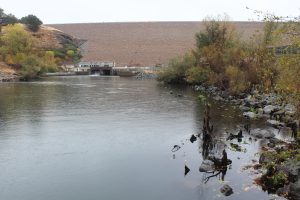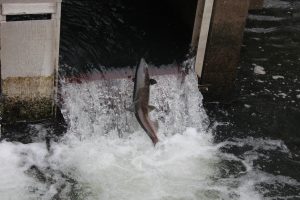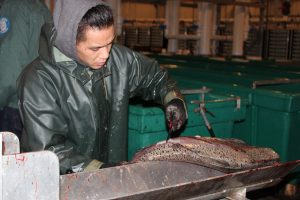For many years after Camanche Dam was built, the Mokelumne River, a major tributary of the San Joaquin River and the Delta, hosted small runs of Chinook salmon.
The historic runs of steelhead after the construction of the dam averaged only 100 fish and no steelhead returned to spawn many years.
But both steelhead and salmon runs have rebounded in recent years, due to a number of factors. In welcome good news for Central Valley salmon populations, the California Department of Fish and Wildlife (CDFW) and the East Bay Municipal Utility District (EBMUD) report record fall spawning returns of Chinook salmon and steelhead to the Mokelumne River.

The hatchery staff has trapped a total of 10,742 adults to date, a combination of 5.908 grilse and 4,834 adults. A total of 15,444 salmon had been recorded over Woodbridge Dam as of November 15, according to Will Smith, hatchery manager.
The run is on track to break the record run of 18,000 fish in 2011 that went over Woodbridge Dam near Lodi. That year, 15,922 salmon were trapped by the fish hatchery.
Over a three-hour period on November 16, staff at the Department of Fish and Wildlife’s Mokelumne River Fish Hatchery in Clements spawned fall-run Chinook salmon as school children toured the hatchery and photographers and TV cameramen from a variety of media outlets captured the activities.
The salmon season is at its peak now — and the hatchery will continue to spawn fish as they move into the facility. Smith said they should continue spawning through December 18.
“I think the big showing of fish bodes well for the ocean fishery this coming year,” said Smith.
For the second year in a row, the hatchery has also counted a record number of steelhead, with more than 616 adults and 340 half pounders having already entered the hatchery in 2017. This follows last year’s record return of 719 adult steelhead and 402 half pounders to the facility.
On November 22 alone, the hatchery staff had trapped 38 adult steelhead. “We expect to start spawning the steelhead starting the week of December 18 and should keep spawning through the end of February,” said Smith.

He said the hatchery usually sees two surges of steelhead – the first from late October through early November and the second from Christmas to the middle of January. “The steelhead we’re now seeing are silvery fish, mostly 19 to 24 inches long, that have been to salt, not the typical resident fish that we often see here,” said Smith.
This and last year’s steelhead numbers are remarkable considering that no steelhead came back to the hatchery for 10 years from 1976 through 1986. Again in 1998-1999, no adult steelhead returned to the facility.
“There is a long list of factors responsible for the rebound of salmon and steelhead,” said Smith. “These include good ocean conditions, a change in our juvenile salmon release strategies, a special barging program of salmon downriver, and closing the Delta Cross Channel gates on weekdays to prevent straying of both Sacramento and Mokelumne River salmon.”
Another major factor behind the boom in numbers of steelhead is the management of the river as a steelhead fishery. Before the listing of the Central Valley steelhead under the

Endangered Species Act (ESA), the Mokelumne was managed as a catchable trout fishery, rather than as a wild steelhead or trout river.
The CDFW used to regularly stock the river with catchable size steelhead in the 10 to 15-inch range, hatched from steelhead eggs obtained from the Mokelumne and Nimbus Fish hatcheries.
EBMUD officials confirmed the factors mentioned by Smith to explain the record salmon and steelhead runs.
“The impressive fall returns are a result of combined efforts that have focused on water operations, including managing cold water in Camanche and Pardee reservoirs to attract salmon, releasing pulse flows, Delta Cross Channel gate closures, and using tagging data to evaluate hatchery release strategies,” reported Tracie Morales of EBMUD in a statement. “Additional innovative measures include transporting juvenile salmon by barge and feeding a specialized diet to assist the freshwater-to-seawater transfer.”
The agency said these fish returns “indicate a healthier river system that supplies water to 1.4 million East Bay customers.”
The partnership between CDFW and EBMUD is part of a 1998 agreement between the East Bay utility and federal and state agencies to promote healthier conditions and water flows in the Mokelumne River, an agreement that couldn’t have happened without pressure by the California Sportfishing Protection Alliance (CSPA) and Committee to Save the Mokelumne River.
“As a water agency that is a vital partner on the Mokelumne River, we’re thrilled to see continuously strong returns,” said EBMUD Manager of Fishery and Wildlife Jose Setka. “For EBMUD, the health of natural ecosystems is critical to our watersheds and a vital part of our mission. This river partnership has enabled management decisions that have improved the survival of salmon and steelhead. By improving habitat, updating hatchery practices, better coordinating Delta operations and continuing scientific studies, the Mokelumne River fish population will be model for recovery.”
The “Speece Cone” operated by EBUD at Lake Camanche, a device that distributes oxygen to the lower lake waters at the dam, has also boosted the river’s steelhead and resident rainbow fishery.
Besides hatchery improvements, the construction of new fish passage facilities on the new Woodbridge Dam in the summer of 2006 and the completion of the FERC relicensing process for Camanche Dam in 1999 that provides for increased river flows are responsible for the upswing in the salmon and steelhead turns.

The California Sportfishing Protection Alliance (CSPA) and Committee to Save the Mokelumne River played a key role in securing more water for the river from EBMUD, increasing the allotment from only 13,000 acre feet of water to 85,000 acre feet of water in flows, and other efforts to restore the river.
“This is a true success story,” said Bill Jennings, CSPA Executive Director. “EBMUD has a good team of biologists working for them. This is the end result of all of the hearings and litigation that CSPA and the Committee engaged in from the mid-1980s to the mid-1990s.”
Before the minimum flows were secured, the river would sometimes dry up below Woodbridge Dam near Lodi. “We sued over the public trust, causing FERC to reopen the hydroelectric power negotiations so they were forced to develop an EIR,” said Jennings.
One of the major battles CSPA and the Committee engaged in was filing a lawsuit over the Penn Copper Mine above Lake Camanche, a case that went all of the way to the Supreme Court of California. The toxic runoff from the mine would periodically “sterilize” the river, causing die offs of steelhead and other fish, said Jennings.
“The average overflow of hazardous waste into the river from the mine amounted to two Exxon Valdez spills every year,” he said. “
The NPDIS issued in the wake of the Penn Mine lawsuit was the first time in the nation that a regional water board, the Central Valley Regional Water Quality Board, was found to be in violation of the law. As authorized by the Clean Water Act (CWA), the NPDES Permit Program controls water pollution by regulating point sources that discharge pollutants into U.S. water.
“EBMUD was forced to do a huge remediation, putting 13 million cubic yards of mining waste into a huge land fill,” he said.
More recently, CSPA and other groups halted EBMUD’s plan to expand Pardee Reservoir. their plan to expand Pardee Reservoir.
For more information on the Mokelumne River Fish Hatchery, call (209) 759-3383.
Improved Mokelumne Salmon & Steelhead Return Strategies
Stronger Pulses – Pulse flows reached higher magnitudes compared to recent years thanks to flood control waters released from Camanche Reservoir. These pulses provide cues for salmon to move up into the river. Additional pulses provided by reoperating Woodbridge Irrigation District Dam extended the period of pulses into November.
Gate Closures – To prevent straying of Sacramento and Mokelumne River salmon, CDFW coordinated closures of the Delta Cross Channel Gates on weekdays and reopened for weekend recreation beginning in September.
Tagging Data – Using Coded Wire Tag data from returning fish, the agencies measured the effectiveness of releasing fish on outgoing tides and limiting releases to no more than two consecutive days from the same location to increase juvenile salmon survival.
Barging – The agencies have transported juvenile salmon from the Mokelumne River by barge and released them in the San Francisco Bay. Barging improves fish survival through the Delta and may also help with imprinting for juvenile salmon to re-trace their way to natal waters.
Transfer Diet – Juvenile salmon undergo an incredible physiological change when moving from freshwater to saltwater. To ease the initial stress, a specialized feed containing higher salt levels is fed to the juveniles in the weeks before the release.
Habitat Improvement – EBMUD and DFW have spent nearly two decades developing and implementing a plan to improve spawning and rearing habitat in the river below Camanche Dam.
Fishing Regulations
The Mokelumne River (San Joaquin Co if open from Camanche Dam to Highway 99 bridge is open from Jan. 1 through Mar. 31 with a limit of 1 hatchery trout or 1 hatchery steelhead.
It reopens from Fourth Saturday in May through July 15 with a limit of 1 hatchery trout or 1 hatchery steelhead.
Form July 16 through Oct. 15, the limit is 1 hatchery trout or hatchery steelhead and Chinook salmon.
From the Highway 99 bridge to the Woodbridge Irrigation District Dam including Lodi Lake, the season is from Jan. 1 through July 15 with a limit of 1 hatchery trout or 1 hatchery steelhead,
From July 16 through Dec. 31, the limit is 1 hatchery trout or hatchery steelhead and 2 Chinook salmon.
The section between the Woodbridge Irrigation District Dam and the Lower Sacramento Road bridge is closed to all fishing all year.
The Mokelumne River and its tributary sloughs downstream of the Lower Sacramento Road bridge and east of Highway 160 and north of Highway 12 from Jan. 1 through July 15 has a limit of1 hatchery trout or 1 hatchery steelhead.
From July 16 through Dec. 16, the limit is 1 hatchery trout or hatchery steelhead and 2 Chinook salmon.
From Dec. 17 through Dec. 31. The limit is 1 hatchery trout or 1 hatchery steelhead.
